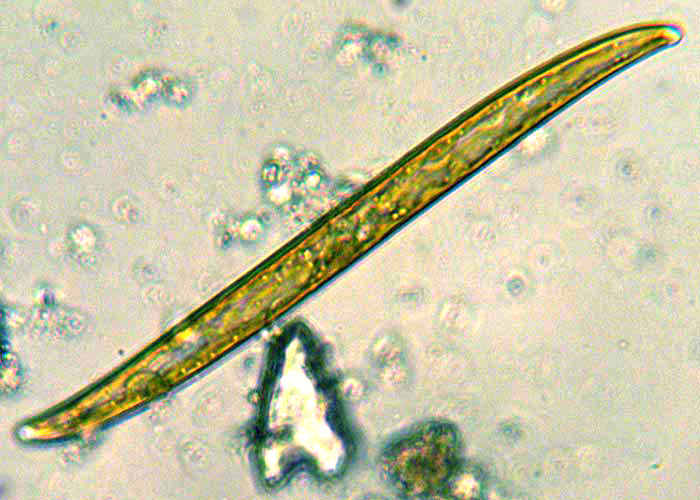Excerpts from Jim Conrad's
Naturalist Newsletter

from the December 23, 2012 Newsletter issued from the valley of the Dry Frio River in northern Uvalde County, southwestern Texas, on the southern border of the Edwards Plateau; elevation ~1750m (~5750 ft); N29.62°, W99.86°; USA
A PENNATE DIATOM
While scanning a drop of water from a shallow, stagnate pool beside the little Dry Frio River behind the cabin I was about to give up on finding anything interesting when I noticed that at a size much smaller than I was focusing at many slender, pointed items were suspended in the water. I increased the magnification as high as I could and saw what's shown above.
There were jillions of them, obviously important in the pool's ecology, and I didn't know what they were. Hours of work with an image-search engine finally turned up a picture matching what's shown above. It's one of many kinds of diatom, though I can't say which one it is. A page on diatoms produced at Berkely University says "It is a brave thing to identify a Diatom by genus. It is a foolhardy thing to attempt its species*."
Diatoms are have true cells with defined nuclei enclosed in nuclear membranes, and they photosynthesize with chloroplasts, so they are classified as algae, which are plants, The largest diatoms are only about 2mm long (1/16+ inch long). The one about is about 200 micrometers (0.008 inch) long. They are unicellular.
Traditionally diatoms have been divided into two orders:
The one above is a pennate diatom.
Referring to the Diatoms of the United States website, I see that further it is defined as a Nitzschioid diatom.
Diatoms constitute one of the most common types of phytoplankton -- freely floating, microscopic, photosynthesizing organisms .In the broader scheme of things, diatoms help us air breathers by photosynthesizing and producing oxygen. They further contribute to the ecosystem by being fed upon by such microscopic creatures as the horn-shaped Stentor, which themselves are fed upon by larger organisms, and so on up the food chain.